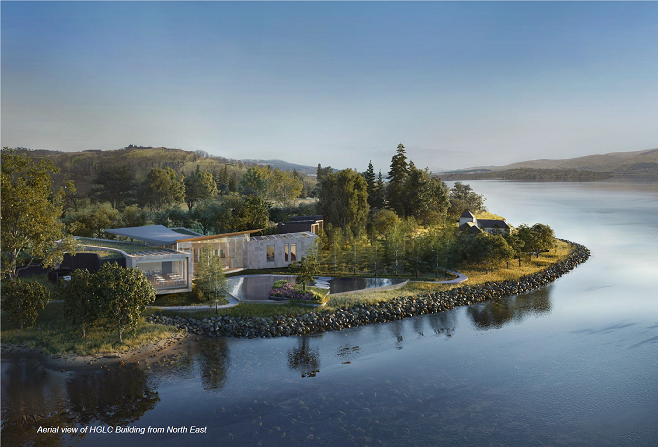
Back in February I blogged about the Hunter Foundation’s proposals to develop a “Global Leadership Centre” on the shore of Loch Lomond near Ross Priory in partnership with Strathclyde University (see here). A Planning Application was submitted at the beginning of March (see here for planning papers) and has been slowly progressed during the Covid-19 lockdown. It has now been re-advertised with the official statutory consultation ending on 23rd June. There are many reasons why people who care about Loch Lomond should lodge objections.
Location of the proposed Hunter Foundation development
The shore of the south east corner of Loch Lomond, from Balloch Castle Country Park to Balmaha, is undeveloped, and very special because of that.
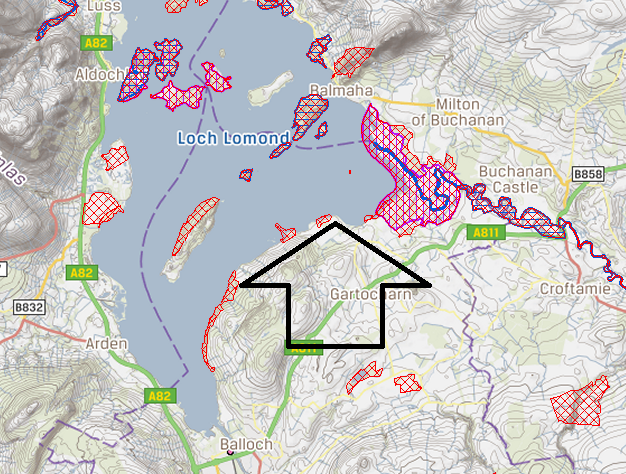
The area is also covered by a host of designations. The development would be located on one of the few sections of loch shore that is not protected by nature conservation designations. It is however in the Loch Lomond National Scenic Area and in the most prominent position possible. It is therefore very attractive from a developer point of view, offering exclusive views out over Loch Lomondand over a part which is extremely important for wildlife.
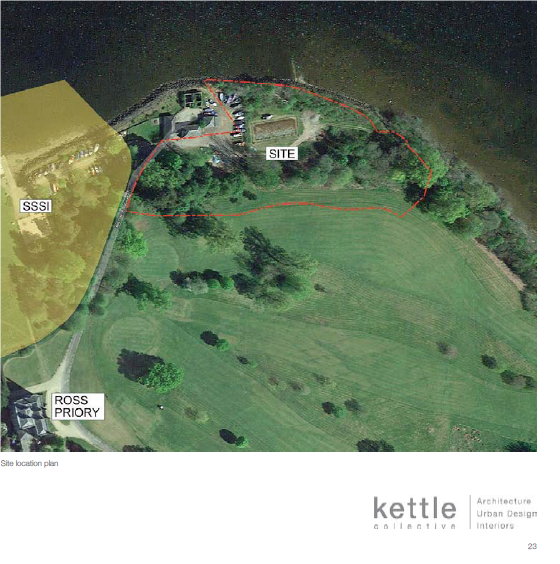
While part of a joint initiative with Strathclyde University, who own the land, the development omits Ross Priory, a Grade A listed building, and the Stable Block, close to the loch shore. Both are in need of investment and repair. The site is situated within the Designed Garden and Designed Landscape of Ross Priory which has an interesting history (see here).).
Planning process
The site was not earmarked for any development in the Loch Lomond and Trossachs National Park’s Local Development Plan. This contains a general presumption against development in the countryside, with exceptions for certain small-scale developments. The proposed development is large, comprising a conference centre with four associated accommodation pods. One would have expected, given its position, that when first approached about the development the LLTNPA would, have simply said no.
Instead, a Freedom of Information response indicates that the LLTNPA appears to have done all it could to help the Hunter Foundation circumvent the Park’ own policies. After Pre-Application discussions, which took place in August 2019, officers advised (see here) that while the development did not fit the LLTNPA’s economic development policy it could:
“potentially receive support in principle as an exception to this policy as it could support the viability of Ross Priory. Supporting evidence in the form of a comprehensive estate wide business management plan should be provided to demonstrate how the operation of the leadership centre would support the operation/sustainability of Ross Priory and the wider estate”.
Having opened the door to a Planning Application, the application submitted to the LLTNPA by the Hunter Foundation contains no proposals for investment or repair of the listed buildings.
What is also extraordinary is that, given the sensitive position of the site, the Hunter Foundation has been allowed to submit the application without any Environmental Impact Assessment.
The way the current planning system currently operates in the LLTNPA undermines the founding principles of our National Parks which are about putting conservation of the natural and cultural heritage first. Instead of drawing clear lines, the LLTNPA has a history of bending its rules to mae developments, however ill-conceived and whatever the location, happen. Many, such as poorly designed hydro schemes, have got through because no-one noticed.
Increasingly, however, inappropriate developments in the National Park are being met by public outcry. The LLTNPA then faces a dilemma, whether to push ahead or back track. It often ends up fudging for months or more (as it did over Flamingo Land (see here)) until it knows which way the political winds are blowing. The whole process is disastrous for the National Park’s reputation. Either it alienates the public or developers are led down the garden path at considerable expense. With increasing local opposition, the Hunter Foundation Planning Application exemplifies this process.
A planning system fit for purpose would have directed the Hunter Foundation elsewhere. No-one would have opposed them if, in partnership with Strathclyde University, they had wanted to repair and upgrade Ross Priory and the decaying buildings associated with it. Alternatively, if the Foundation was intent on a loch side site, the torpedo station at Arrochar (see here) has been derelict for years and is earmarked for development. Other alternative sites for a Leadership Training Centre include Balloch Castle and the former outdoor centre at Ardlui , both of which are accessible by public transport.
Instead of being proactive and directing developers to appropriate places, the LLTNPA is stuck on responding to “the market” and enabling developers achieve their objectives, however inappropriate. There is no consistency. Last year, the LLTNPA rejected a development at the neighbouring Wards’ Estate (see here) for additional accommodation to support functions held there. (This is sandwiched between Ross Priory and the RSPB Wards Farm Nature Reserve where the LLTNPA recently approved a new path (see here)). The developer, De Vere Capital Ltd, appealed. Their appeal was, a week ago, recently been rejected by the Government’s Reporter (see here) who found the proposed development:
- “does not, in my view, conserve or enhance the natural and cultural heritage of the area” and
- “the scale proposed is not appropriate within the national scenic area”.
The Hunter Foundation’s proposed development is in a far more sensitive position in both landscape and nature conservation terms. So how has the LLTNPA allowed it to get this far?
The shoreline and flood plain
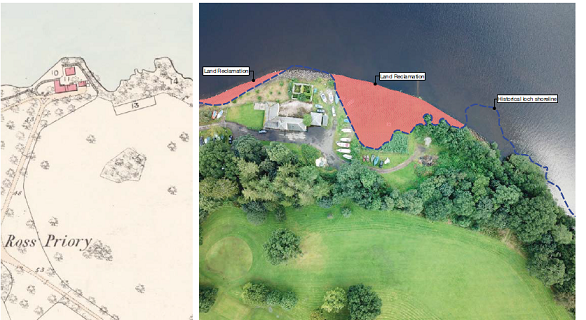 The shoreline where the development is proposed includes reclaimed land, has been highly modified and is now “protected” by rip-rap bouldering (see also top photo). Instead of exploring how this section of the shore could be returned to its natural state, the LLTNPA’s planning system encourages an endless process of attrition with development damage, however small, being used to justify more damage.
The shoreline where the development is proposed includes reclaimed land, has been highly modified and is now “protected” by rip-rap bouldering (see also top photo). Instead of exploring how this section of the shore could be returned to its natural state, the LLTNPA’s planning system encourages an endless process of attrition with development damage, however small, being used to justify more damage.
The reclaimed area is still part of the flood plain, as this map of the proposed development shows:
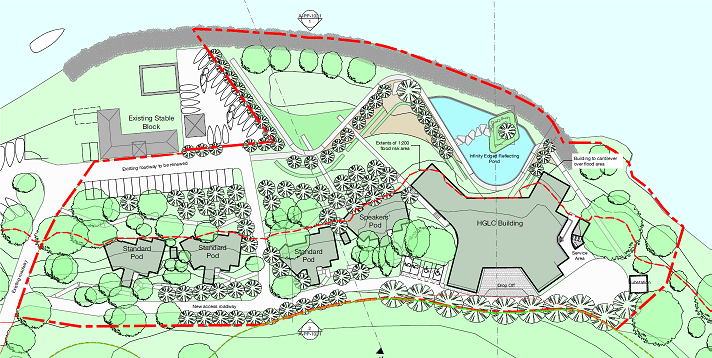
The Scottish Environmental Protection Agency (SEPA) has now objected to the application (see here). Its objection explains it had met with the applicant in July 2019 and is disappointed the advice it gave then has been ignored. It says too much of the development is on the functional flood plan – in plain words is utter folly. What insurance company would want to provide insurance cover to a development that could be flooded?.
SEPA also comments on the artificial “Infinity Edged Reflecting Pool”, a bit of glitz on a piece of land that mostly hasn’t been reclaimed and is now covered by trees. It says its preferred option would be for an untreated or unfiltered system rather than a filtered system of “chemically treated pool to provide clear water”. The issue, in my view, is far greater than the type of water in the pool. How has a National Park Authority got itself into a position where it is now considering the “merits” of an artificial pool by the edge of what is probably the finest expanse of inland water in Scotland?
Pollution of the richest part of Loch Lomond for wildlife
It is conservation anomaly that while most of the shore around the south-east corner of Loch Lomond is protected by designations, the loch itself is not, despite its importance for wildlife. It is shallow, fed by the waters of the River Endrick and hosts an important range of aquatic wildlife. It is full of fish, reflected in its importance as a hunting ground for osprey, while wild fowl nest along the shore in summer and congregate in large numbers in the winter.
The proposed development is within 1-2 kilometres of the National Nature Reserve and Ramsar designated wetland site. Given this, you might be surprised that the development proposes – detailed plans are still absent – to discharge c2 million litres of effluent into the Loch Lomond each year. The loch already suffers from algal blooms and, like many other water bodies in the National Park, its water quality disgracefully, well below the Scottish average (see here). The issues are well described by the Loch Lomond Angling Improvement Association in their response to the application:
 SNH, the lead body for species conservation in Scotland, stated in their response that:
SNH, the lead body for species conservation in Scotland, stated in their response that:
“We have also changed our service statement and no longer offer bespoke advice to routine protected species issues. We now fulfil our advisory role on protected species through the provision of standing advice and do not expect to be consulted except in exceptional circumstances not covered by our standing advice”.
SNH’s staff, who have been cut dramatically, are still given time to issue hundreds of licenses each year to kill species such as beavers that they were set up to protect (see here).
SEPA have, however, thankfully included water quality in their objection (an original holding response has been removed from the planning portal) which states they “have a strong presumption against a discharge to a freshwater Loch”. The proposals to discharge effluent into Loch Lomond are unnecessary because Scottish Water has plenty of sewerage capacity nearby:
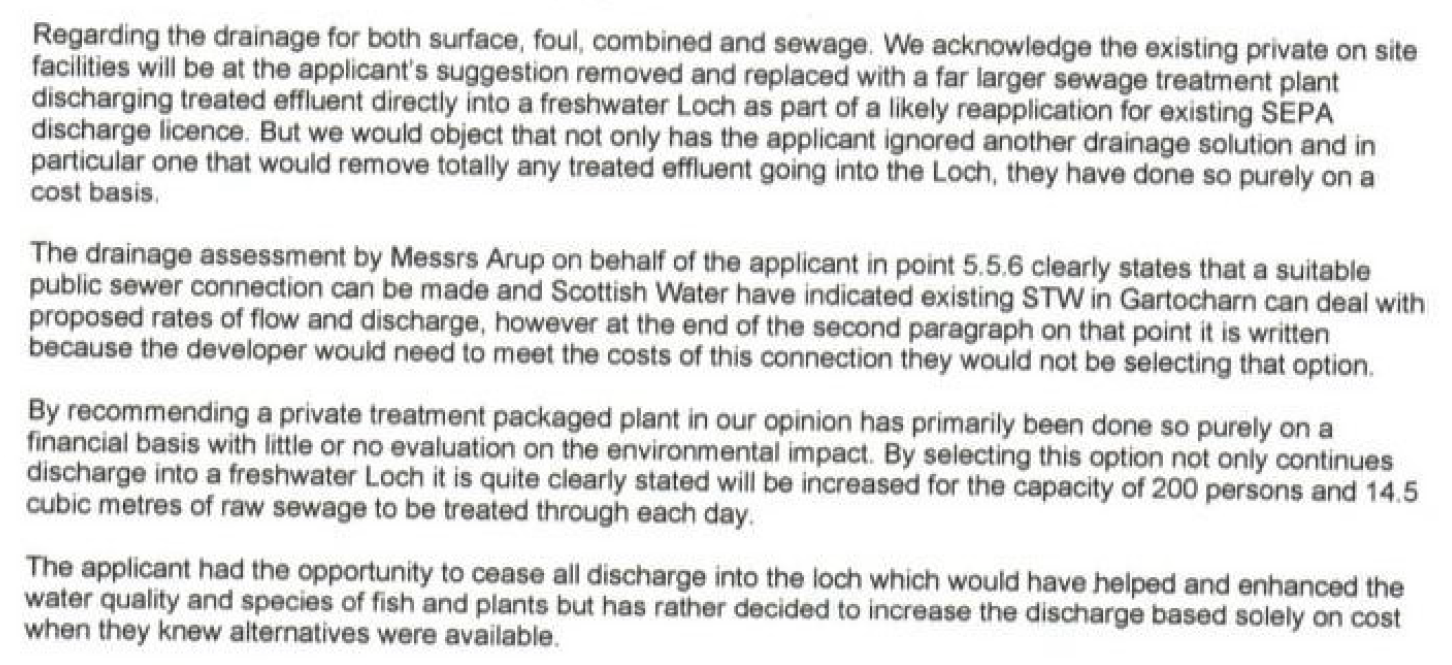
The explanation for the effluent comes down to money. The Hunter Foundation wants, in Sir Tom Hunter’s words, a “world class leadership centre” but on the cheap. Unfortunately SEPA, while having a strong presumption against discharging dirty water into lochs, says it will make an exception for “economic reasons”. In this case that means that if the Hunter Foundation, funded by one of the richest men in Scotland, can show the costs are too high they could waive their objection. Whether SEPA hold their position may depend on public and political pressure.
The effluent proposal also makes a mockery of the LLTNPA’s commitment to reduce “point source” pollution into lochs by 2023.
Associated developments
The footprint of the five buildings contained in the Planning Application covers a larger footprint than Ross Priory. The Design Statement submitted with the application, however, indicates this is not all. There are a significant number of other developments associated with it, increasing the footprint further, which are likely to spawn further planning applications in future. These include:
- “Enable investment in derelict and semi-derelict buildings to support both Ross Priory and the HGLC [Hunter Global Leadership Centre] in overspill and storage capacity“. So what is the overspill and how is it intended to use these buildings?
- “Upgrade 6 laybys” along the single track road to Ross Priory;
- “land improvements in walkway and slipway“
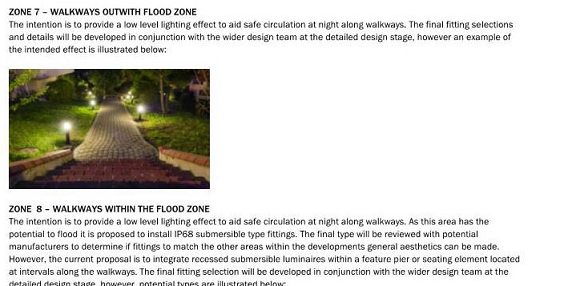
- The slipway improvements could either be linked to the suggestion the developer might “Seek to extend the existing water taxi service from Balloch” or provide “Water activities” for those staying at the Centre;
- “bulk photovoltaic solar array” to power both Ross Priory and the HGLC. These are likely to be placed in a field, which will have a significant impact on the natural environment and landscape (solar panels should be on roofs on buildings).
In sum, the Planning Application is part of a much bigger development. In planning terms, had this been submitted as a single application, a masterplan should have been required. In lay terms, the proposals will suburbanise what is currently a rural area.
Overall purpose of the development
Apart from providing a global leadership centre, a major part of the Hunter Foundation’s justification for the development is to bring new investment into Ross Priory. Historic Environment Scotland put their finger on part of the issue. While their response stated “our decision not to object should not be taken as support for the proposals” they clearly call for ALL the listed buildings “to be incorporated into the scheme at this stage.” Why haven’t they been?
This raises the question of whether the Hunter Foundations’ promise to bring new investment to Ross Priory is empty, or conversely, whether the leadership centre is a smokescreen for Strathclyde University to expand their wedding and hospitality venue rather than repairing the listed buildings? It is clear from the application that the new buildings will be used as overflow accommodation for Ross Priory and could simply be used as upmarket self-catering accommodation.
The Planning documentation raises more questions than it answers.
Other issues
There are a host of other issues associated with the development:
- What you can see looking out (though just where the little island has come from I am not sure), can be seen by others looking back
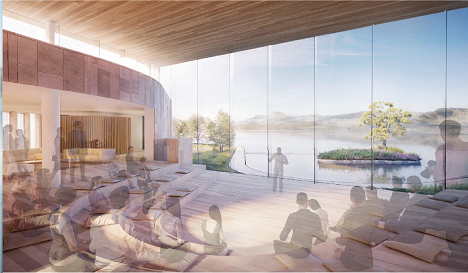
- The LLTNPA has clearly advised the developers to reduce the light pollution, as there are proposals for softened lighting, but that won’t deal with the fundamental issue of glass fronted buildings being built on the edge of the loch. The “softening” is alsoundermined by all the lighted walkways.
- While Tom Hunter claimed the development was in a woodland glade, the photos show this is not the case. The plans include the removal of 31 mature trees. Planting 90 new ones will take years to compensate for this.
- In terms of the designed landscape, the number of cars driving in front of Ross Priory will increase and the two buildings will be mutually visible through the trees each other.
- The Kilmaronock Community Council has expressed concerns that the responses from LLTNPA’s in-house advisers on the landscape and wildlife impacts of the development (totally independent of course) have not been made public. Unless they are published, it’s impossible for the public to question them or ascertain if they are adequate or not (the published wildlife impact assessments are inadequate as detailed in several of the objections lodges so far).
- Depending on what exactly is proposed, water activities, could have a significant impact on wildlife and other recreational use of the loch. The Vale of Leven District Angling Club has pointed out how the area offshore is very important for salmon trolling (currently any salmon caught are I understand returned to the loch) and explained the impact of motor vessels on this activity.
- While the development land is just outside the geomorphological Site of Special Scientific Interest, designed to protect deposits left by the last Lomond glacier, the development would affect other undisturbed glacial deposits. Two geomorphologists have recommended that if the development is approved, all works should be carefully supervised by scientists.
What needs to happen
This post has explained why a development is inappropriate on the shore of Loch Lomond by Ross Priory and some of the major issues raised by the Hunter Foundation’s application. In this case I have deliberately tried to avoid describing these issues in planning terms. This is partly because I believe the practice of evaluating proposed developments against long lists of plans and policies has resulted in our Planning Authorities losing sight of the big picture. The focus on technical planning policies generally favours developers and the professionals they hire to get development proposals through. But it is also because in this case a local resident has hired a planning consultant to explain what is wrong with development in planning terms. This is on the planning portal but I have downloaded here.
If you want to lodge an objection or otherwise comment you can do so via the LLTNPA Planning Portal (see here). It’s best to try and do so before the 23rd June although the LLTNPA, to its credit, usually allows objectors to continue to lodge comments after statutory consultation periods are over.
Who is this building for? and what exactly is a reflecting pool?
Rationale for the Global Leadership centre covered in earlier post, links above. For reflecting pool
The submersible lights for the path is this real.???so you can see the top of your wellies at night or is it to see the increased amount of human waste floating about they could divert the effluent through the infinity pool to give a stunning visual interpretation of the garbage floating around in their minds
As taken from the Hunter foundation Website:
‘The Hunter Foundation (THF) is a proactive venture philanthropy that seeks to invest in determining model solutions, in partnership with others, to troubling systemic issues relating to poverty eradication and educational enablement.’
From what has been written above it doesn’t sound like they are trying to follow ‘model solutions’ in a sensitive environment and surely ‘education enablement’ means that they have a responsibility to lead by example showing the right way to find correct solutions with consideration to local concerns.
There comes a point when nature at it stands is more important to preserve than commercialise for
whatever reason. Mass public access can cause such damage, often irreparable, and thus destroys it
for future generations. I cannot see this type of development being of any value bearing in mind there’s
an abundance of accessible already to appreciate and enjoy.
Although we do not live in the National Park we frequently visit and would not want to see any development in this area which is under 1km from a highly designated NNR and connected to the proposed development site by water. In the pre application advice given to the Hunter Foundation why was an EIA not called for? This gives me reason to object to this application. The environment within a National Park should be conserved for the bio diversity of the eco systems that it nurtures and also as a place for people to appreciate the unspoilt, undeveloped outdoors.